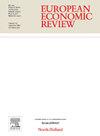工作分离冲击,昂贵的职位空缺和工作配给
IF 2.8
2区 经济学
Q1 ECONOMICS
引用次数: 0
摘要
本文表明,准确评估匹配摩擦和工作配给在美国失业中的作用需要一个模型,该模型能够捕捉到在工作分离冲击后观察到的劳动力市场紧缩程度的下降。工作配给模型的自由进入版本低估了匹配摩擦的影响,而不是强调工作配给是美国失业的主要驱动因素,因为它产生了反事实的紧缩增加,从而提高了就业率,减少了由匹配摩擦引起的失业率。相反,包含空缺创造成本的昂贵入门版本,准确地再现了观察到的紧缩程度下降,表明美国失业主要是由匹配摩擦驱动的。劳动力市场紧缩对工作分离冲击的反应是由两种相反的效应形成的:边际产品效应(增加紧缩)和资本化效应(减少紧缩)。包括空缺创造成本加强了资本化效应,超过了边际产品效应,并导致观察到的紧缩程度下降。这些发现强调了将创造空缺成本纳入准确衡量匹配摩擦对失业影响的重要性。本文章由计算机程序翻译,如有差异,请以英文原文为准。
Job separation shocks, costly vacancy creation and job rationing
This paper demonstrates that accurately assessing the roles of matching frictions and job rationing in U.S. unemployment requires a model that captures the observed decrease in labor market tightness following a job separation shock. The free entry version of the job rationing model underestimates the impact of matching frictions, instead emphasizing job rationing as the primary driver of U.S. unemployment, because it produces a counterfactual increase in tightness, which raises the job-finding rate and reduces unemployment attributed to matching frictions. Conversely, the costly entry version, which incorporates vacancy creation costs, accurately reproduces the observed decline in tightness, indicating that U.S. unemployment is primarily driven by matching frictions. The response of labor market tightness to a job separation shock is shaped by two opposing effects: the marginal product effect, which increases tightness, and the capitalization effect, which decreases tightness. Including vacancy creation costs strengthens the capitalization effect, outweighing the marginal product effect, and results in the observed decline in tightness. These findings underscore the importance of incorporating vacancy creation costs to accurately measure the impact of matching frictions on unemployment.
求助全文
通过发布文献求助,成功后即可免费获取论文全文。
去求助
来源期刊

European Economic Review
ECONOMICS-
CiteScore
4.70
自引率
3.60%
发文量
170
期刊介绍:
The European Economic Review (EER) started publishing in 1969 as the first research journal specifically aiming to contribute to the development and application of economics as a science in Europe. As a broad-based professional and international journal, the EER welcomes submissions of applied and theoretical research papers in all fields of economics. The aim of the EER is to contribute to the development of the science of economics and its applications, as well as to improve communication between academic researchers, teachers and policy makers across the European continent and beyond.
 求助内容:
求助内容: 应助结果提醒方式:
应助结果提醒方式:


